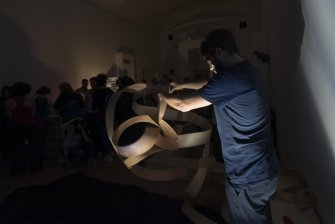Luca Trevisani
Luca Trevisani è un artista la cui pratica multidisciplinare è stata esposta a livello internazionale in musei e istituzioni, tra cui MAXXI Roma, Biennale of Sydney, Manifesta 7 Rovereto, Biennale di Architettura di Venezia, MOT Museum of Contemporary Art Tokyo, Kunsthalle Wien, Kunstverein Braunschweig, ZKM Karlsruhe, Magasin Grenoble, Museion Bolzano, Live Arts Week Bologna. Oltre a premi e mostre in importanti centri d’arte e musei ha pubblicato diversi libri tra cui: The effort took ist tools (Argobooks, 2008), Luca Trevisani (Silvana Editoriale, 2009), The art of Folding for young and old (Cura Books, 2012), Water Ikebana (Humboldt Books, 2014), Grand Hotel et des Palmes (NERO Editions, 2015), Via Roma 398. Palermo (Humboldt Books, 2018), Walking loaves (NERO, 2023), Insalata di Fossili (COLLI, Viaindustriae, 2024) e realizzato il documentario di fantascienza Glaucocamaleo (2014). Ha scritto testi e saggi, tra gli altri, sul lavoro di Francesco Lo Savio, Luca Vitone, Giovanni Anceschi, Gianni Colombo, Liam Gillick, Mark Manders. Ha pubblicato il disco AMAZOOM per Xong collection - artist records (Xing, 2025). Insegna allo IUAV a Venezia, presso la Libera Università di Bolzano e alla NABA a Milano. La sua ricerca spazia fra la scultura e il video, e attraversa discipline di confine come le arti performative e quelle grafiche, l’architettura e il design, il cinema di ricerca o l’architettura, in una perpetua condizione magnetica e mutante. Nelle sue opere le caratteristiche storiche della scultura sono interrogate se non addirittura sovvertite, in un’incessante indagine sulla materia e sulle narrazioni. La traiettoria della ricerca di Trevisani è quella di un esploratore; un libero pensatore che studia con curiosità – ma anche con distacco – le più diverse ed eclettiche forme del linguaggio plastico, agendole dall’interno pur senza mai ambire a possederle definitivamente, ma piuttosto cercando di svelarne – e se possibile modificarne – la loro microfisica. Conservando sopra ogni altra quell’assoluta passione per l’utilità pratica e sociale del proprio lavoro e per le grandi questioni che esso coltiva, che costituisce forse la vera cifra di chi pratica con autorevolezza la ricerca artistica.
www.lucatrevisani.eu lucatrevisanipictures.com latecomerforerunner.blogspot.it
Luca Trevisani is a multidisciplinary artist based in Milano, whose works have been exhibited in museums and institutions throughout the world, including MAXXI in Rome, Biennial of Sydney, Manifesta 7 Rovereto, Biennial of Architecture in Venice, MOT Museum of Contemporary Art in Tokyo, Kunsthalle in Vienna, Kunstverein in Braunschweig, ZKM in Karlsruhe, Museion in Bozen, Live Arts Week in Bologna, Magasin in Grenoble. In addition to awards and shows in major art centres and museums, he has published several books, including: The effort took its tools (Argobooks, 2008), Luca Trevisani (Silvana Editoriale, 2009), The art of Folding for young and old (Cura Books, 2012), Water Ikebana (Humboldt Books, 2014), Grand Hotel et des Palmes (NERO Editions, 2015), Via Roma 398. Palermo (Humboldt Books, 2018), Walking loaves (NERO, 2023), Insalata di Fossili (COLLI, Viaindustriae, 2024), and directed the science-fiction documentary film Glaucocamaleo (2012). He has written texts and essays on the works of artists such as Francesco Lo Savio, Luca Vitone, Giovanni Anceschi, Gianni Colombo, Liam Gillick, and Mark Manders. He released the LP AMAZOOM for Xong collection - artist records (Xing, 2025). He teaches at IUAV in Venice, at the Free University of Bolzano, and at NABA in Milan. His research ranges between sculpture and video, and crosses borderline disciplines such as performing arts, graphics, design, experimental cinema and architecture, in a perpetual magnetic and mutant condition. In his works the historical characteristics of sculpture are questioned or even subverted, in an incessant investigation of matter and its narratives. The instability is a characteristic of his work, a developmental status magnetic and mutant that expands and contracts without stopping the boundaries between each element of the work and the environment, which now becomes irradiated, now undisputed. Nothing is stable in his work. Trevisani’s research is that of an explorer: a freethinker who studies the most diverse and eclectic forms of plastic language with curiosity – but also with detachment – acting on them from the inside although never aspiring to possess them definitively, instead seeking to reveal (and, if possible, to modify) their microphysics. Above all, conserving absolute passion for the practical and social utility of his work and for the great questions that it cultivates: perhaps the real significance of someone who conducts artistic research with authority.

